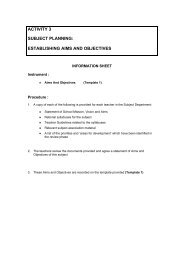Co-Operative School Evaluation Project (File Format PDF 550KB)
Co-Operative School Evaluation Project (File Format PDF 550KB)
Co-Operative School Evaluation Project (File Format PDF 550KB)
Create successful ePaper yourself
Turn your PDF publications into a flip-book with our unique Google optimized e-Paper software.
COOPERATIVE SCHOOL EVALUATION PROJECT<br />
THE INDICATORS<br />
1.2.2 The design indicator<br />
The next three Level 1 indicators from Table 1 are taken from a general literature on planning, action research and<br />
reflective practice. Each of these activities can be described as a cycle of events. A felt need gives rise to an<br />
articulation of a way to meet that need (DESIGN). This planned solution is articulated in terms of an action, and a<br />
process is put in place to support and carry out the action (IMPLEMENTATION). The effect of the action, and in<br />
particular its effectiveness in meeting the expressed need, is then evaluated (IMPACT). The implications of the<br />
evaluation then give rise to further cycles of policy or action.<br />
OPERATIONS<br />
ORGANISATION<br />
PROGRAMS<br />
POLICIES<br />
GOALS<br />
BELIEFS<br />
MYTH<br />
ASSUMPTIONS<br />
PURPOSES<br />
POLICIES<br />
Fig. 2 A <strong>School</strong> energised by its Vision and Beliefs (Starratt, 1995)<br />
The articulation and analysis of the need, and the creation of a policy or action to meet that need, can be termed a<br />
DESIGN phase. Starratt (1995) developed the concept of the school as an onion. He claimed that coming to<br />
understand a school was like peeling the different layers of skin from an onion. As one gradually peels away layers<br />
of activity, one arrives at a core set of assumptions and a myth about good education and schooling. In high<br />
performing schools, this core vision guides all activities. There is a reflective interaction between the answers to<br />
What How and Why questions (Fig. 2). The centrality of vision in effective schools is also present in Sergiovanni’s<br />
notion of moral leadership (1996), in Fullan’s concept of moral purpose (2003), in Leithwood’s concept of<br />
transformational leadership (1999), and in Bolman and Deal’s assertion of the importance of symbolic narrative in<br />
school development (2003).<br />
The centrality of vision is core to the design process. Four of the seven sub-indicators of the DESIGN indicator<br />
reflect this central role (Table 3). Good policies emerge from good theory or in response to sound social policy. The<br />
planning process is based on this premise (Origin). In the absence of vision, planning proceeds on an ad hoc basis,<br />
and merely responds to whims or fashions. In developing a policy design, it is important that the values behind the<br />
policy be made explicit (Value-Driven), and that these values be clearly understood by the planners and by those<br />
who receive the policy (Rationale). Otherwise, planning might become an empty exercise, engaged in as a<br />
compliant response to external requests. Where there is a centrality of vision, there is a link between different school<br />
policies, and there is a deliberate attempt to harmonise new policies and existing ones (Holistic).<br />
2. DESIGN This indicator examines approaches to policy design.<br />
2.1 Origin The policy has a basis in educational or social values.<br />
2.2 Value Driven The values behind the policy are explicit.<br />
2.3 Rationale The values behind the policy are understood.<br />
2.4 Holistic The policy is linked to other school policies.<br />
2.5 <strong>Co</strong>llaborative <strong>School</strong> partners are involved in the design at an appropriate level.<br />
2.6 Targets The design includes targets to be reached.<br />
2.7 Resources The design identifies resources needed for implementation.<br />
Table 3 Level 2 Sub-Indicators for the Design Indicator<br />
18<br />
19

















